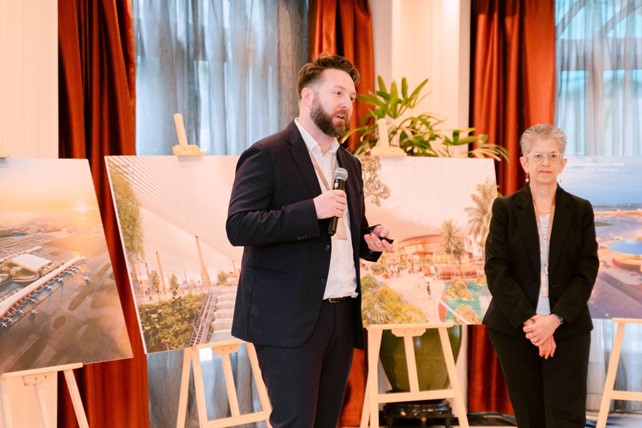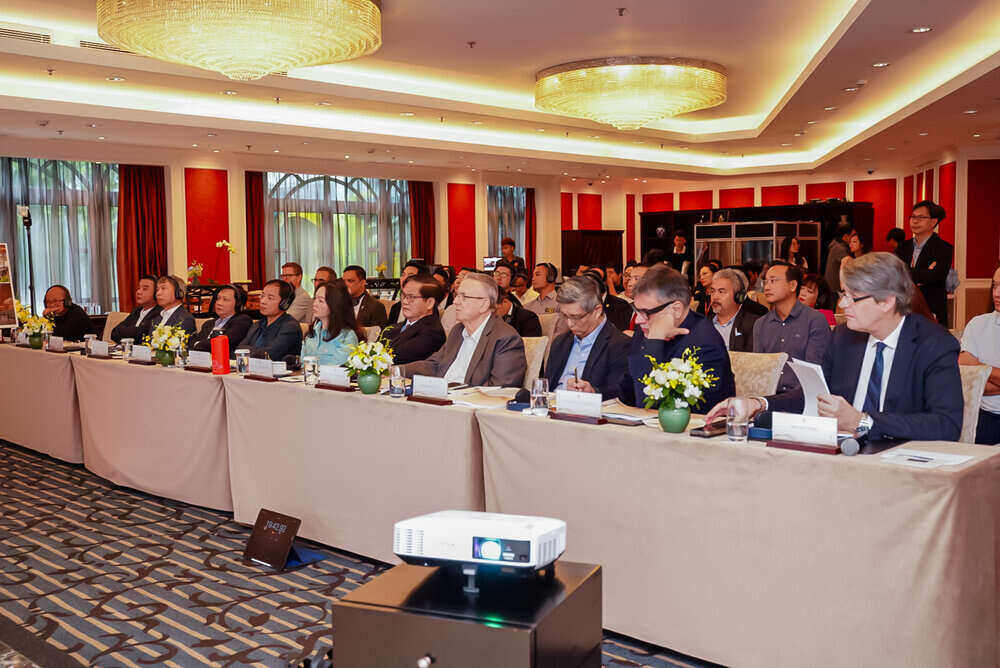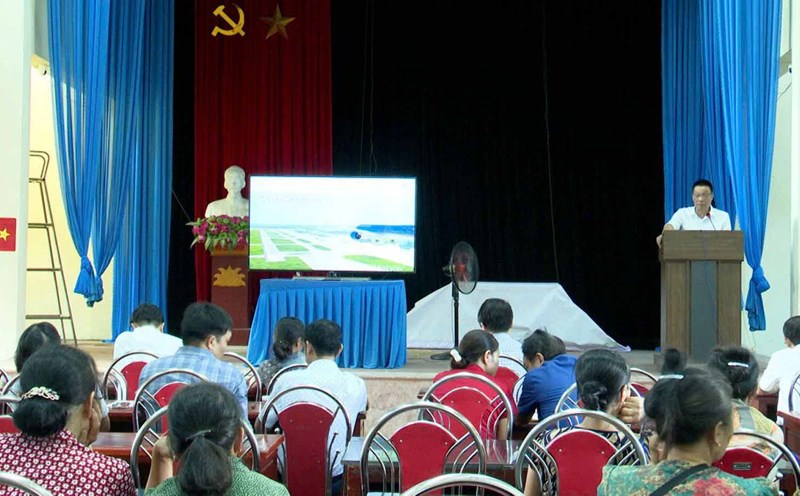Starting the journey to create a gateway to the North, a transit center for passengers and goods and an MRO facility for the Asia-Pacific region

On November 8, 2025, the presentation round of the Gia Binh International Airport Passenger Terminal Architecture Design Competition (Gia Binh International Airport Management Board) officially took place at Sofitel Legend Metropole Hanoi with the participation of three leading architectural companies in the world: Skidmore, Owings & Merrill LLP (SOM) - USA, Nikken Sekkei Ltd. Japan, and Gensler the United States. These three units are all prestigious names behind the terminal design of the world's leading 5-star Skytrax airports, typically Incheon (Korea), Haneda (Japan) and Changi (Singapore).
The contest is organized in the form of an international competition with the goal of selecting a suitable design plan for Gia Binh Passenger Terminal - International Airport, a live presentation process, independent assessment, secret ballot, transparent announcement, ensuring compliance with current legal regulations, professional principles in the fields of architecture, planning and construction.
The plan presentation round is scored by a Board of Judges consisting of leading domestic and international experts from the fields of architecture, planning, aviation and infrastructure development, typically Professor Richard De Neufville (MIT, USA), Architect Moshe Safdie (Safdie Architects) - author of Marina Bay Sands and Jewel Changi Airport, Mr. Cristiano Ceccato de Sabata (Zaha Hadid Architects), Mr. Laurence Liauw (SPADA, Hong Kong) and Mr. Trevor Carnahoff (Jacobs, Australia).
In addition to international experts, the council also had the participation of representatives of the Ministry of Public Security, the Ministry of Construction, the Department of Construction of Bac Ninh province and leaders of Masterise Group, ensuring that the competition fully complied with regulations, rules of law and international professional principles in the fields of architecture, planning and infrastructure development.
Passenger terminal architectural design - a combination of Vietnamese identity and international standards

In the focused and professional atmosphere of the exhibition round, the three participating units all brought their own unique ideas, demonstrating the investment in research, assessment of the current situation of the region and long-term orientation of the Vietnamese aviation industry.
Pursuing the new-generation "smart - green - sustainable" model, meeting the task of socio-economic development, the proposals for designing passenger terminals all take Vietnamese culture and landscape as the foundation of creativity, people as the center - optimizing passenger experience, while ensuring feasibility and sustainability in long-term exploitation.
Many outstanding ideas are highly appreciated by experts, such as the rainwater recovery and reuse system, optimizing natural lighting through skylights, natural ventilation at night, or the use of environmentally friendly materials, low carbon emissions such as wood and terracotta, along with a solar panel system integrated on the roof of the terminal.
These solutions demonstrate the enthusiasm and creativity of the three international teams in participating in creating a comprehensively integrated airport - where architecture, technology and passenger experience are harmoniously connected in the same vision of sustainable development. Each idea aims to honor Vietnamese identity, while shaping new standards for a green, smart and efficient airport model.
Mr. Jordan Pierce, Senior Architect of Skidmore, Owings & Merrill (SOM) - The unit participating in the competition, shared: From the beginning of the research phase, we have wanted to create a project that can touch the emotions of all Vietnamese people, inspired by the country's natural landscape. In particular, the water element - a cultural symbol and national spirit, was developed into the idea of " choice of aquatic gardens", where every journey of passengers is associated with the experience of nature and Vietnamese identity."

The competition options were evaluated by the Jury based on a comprehensive system of criteria, including feasibility, creativity and sustainability, along with the harmony between cultural identity and functional and aesthetic factors. The plans must also meet international standards on modern airport design and operation. The scoring process is conducted objectively, with independent analysis and direct professional dialogue between the parties, ensuring transparency and quality in each decision.
Mr. Laurence Liauw, Executive Director of Sparta (Hong Kong) - Vice Chairman of the Jury, commented: "This is the right time for Hanoi to develop a new airport - a project of strategic significance, contributing to expanding Vietnam's position on the global tourism and aviation map. During the judging process, the Jury carefully discussed each option, evaluating based on criteria from technical value, idea vision to suitability with the Vietnamese cultural context. The most important principle is to optimize the passenger experience, so that everyone when arriving or leaving Gia Binh International Airport has the best experience.
Gia Binh International Airport - A symbol of Vietnam's new power on the international map
As the gateway to the Northern airspace, a transit hub for passengers and goods and an MRO facility for the Asia-Pacific region, Gia Binh Economic Zone contributes to creating growth momentum for the Capital Region, the Northern key economic region and enhancing national competitiveness in logistics, high-tech industry, and large-scale trade and services, creating a long-term development foundation in Vietnam's growth strategy.
Planned according to the technical standards level 4F of the International Civil Aviation Organization (ICAO) and aiming to meet the 5-star Skytrax service standard in operation, Gia Binh International Airport is a national key infrastructure project with strategic significance in economy, security - defense and foreign affairs. With an expected capacity of 30 million passengers and 1.6 million tons of cargo/year by 2030, expanding to 50 million passengers and 2.5 million tons of cargo/year by 2050, the project is expected to rival the leading airlines in the region such as Changi (Singapore), Incheon (Korea) or Suvarnabhumi (Thailand). This will be a new trade hub of Vietnam, where advanced operational standards, a synchronous service ecosystem and strong global connectivity converge, affirming Vietnam's position on the international aviation map.

In addition to technical and functional goals, Gia Binh National Park is also a symbol of infrastructure development associated with green - smart - sustainable criteria. From space planning, construction materials to operation technology, the project focuses on sustainability, energy saving, environmental protection and user experience optimization.
The Gia Binh International Airport Passenger Terminal Architecture Design Contest is organized on an international scale, with serious investment and professional processes, demonstrating the stature and strategic significance of the project as well as Masterise Group's strong commitment to mobilizing maximum international resources, intelligence and technology to contribute to the development of national strategic infrastructure in a sustainable, standard and rich manner in Vietnamese identity.
The Jury of the Gia Binh International Airport Passenger Terminal Architecture Competition includes international experts:
● Prof. Richard De Neufville - Massachusetts Institute of Technology (MIT, USA), Chairman of the Board of Judges
● Mr. Moshe safdie - Architect, urban planner at safdie Architects
● Mr. Cristiano Cecado de Sabata - Director of Zaha Hadid Architects (UK)
● Laurence Liauw - Executive Director of SPADA (Hong Kong), Visiting Associate Professor, Faculty of Architecture, Hong Kong University
Mr. Trevor Carnahoff - Program Director & Head of Aviation Market Solutions, Asia region, Jacobs









